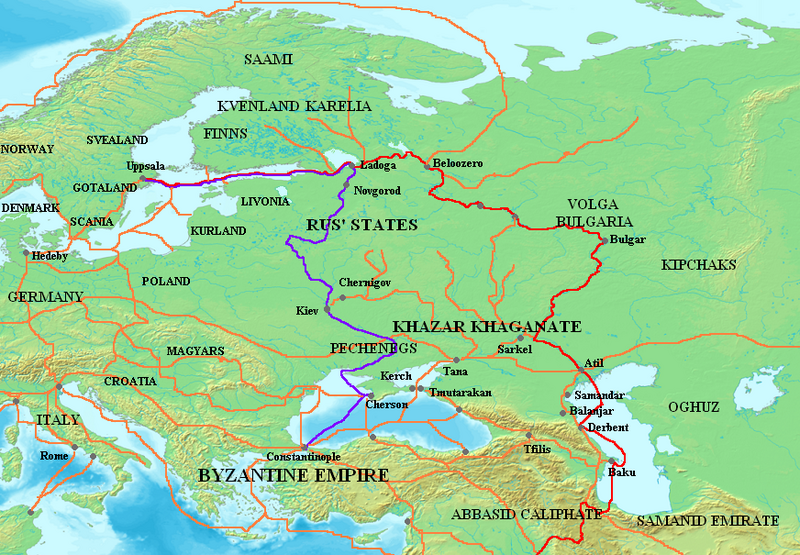Íomhá:Varangian routes.png

Méid an réamhamhairc seo: 800 × 555 picteilín. Other resolutions: 320 × 222 picteilín | 640 × 444 picteilín | 872 × 605 picteilín.
Taispeáin leagan ardtaifigh den íomhá (872 × 605 picteilín, méid comhaid: 859 KB, cineál MIME: image/png)
Stair chomhaid
Cliceáil ar dáta/am chun an comhad a radharc mar a bhí sé ag an am sin.
| Dáta/Am | Mionsamhail | Toisí | Úsáideoir | Nóta tráchta | |
|---|---|---|---|---|---|
| faoi láthair | 11:29, 3 Deireadh Fómhair 2023 |  | 872 × 605 (859 KB) | OrionNimrod | Restore original: "Wallachians" added by Romanian user, however it was no Wallachia in the 8-11th c: British historian, Martyn Rady - Nobility, land and service in medieval Hungary (p91–93): the sources before the 13th century do not contain references to Vlachs anywhere in Hungary and Transylvania or in Wallachia. Byzantine sources mentioned Vlachs all deep in the Balcan. Also map should make by academic historians not by personal POV. |
| 18:23, 16 Lúnasa 2023 |  | 872 × 605 (799 KB) | Claude Zygiel | In one hand there are Byzantine sources which mention the Vlachs, secondly it is not because other sources do not mention them that they did not exist. In the other hand, the Hungarian theory which affirms that "the absence of proof is proof of absence", that this group disappeared for a thousand years, and that it would have been the only one, among all the peoples of the region , to not being able to cross the Balkans, the Danube and the Carpathians (while they were nomadic shepherds), is u... | |
| 10:54, 25 Iúil 2023 |  | 872 × 605 (794 KB) | OrionNimrod | "Wallachians" added by Romanian user, however it was no Wallachia in the 8-11th c: British historian, Martyn Rady - Nobility, land and service in medieval Hungary (p91–93): the sources before the 13th century do not contain references to Vlachs anywhere in Hungary and Transylvania or in Wallachia | |
| 07:29, 26 Meitheamh 2023 |  | 872 × 605 (799 KB) | Johannnes89 | Reverted to version as of 16:47, 18 April 2023 (UTC) crosswiki image spam, often containing historical inaccuracies | |
| 23:53, 25 Meitheamh 2023 |  | 872 × 605 (1,017 KB) | Valdazleifr | Fixed minor errors | |
| 16:47, 18 Aibreán 2023 |  | 872 × 605 (799 KB) | Claude Zygiel | There was no Wallachia but Wallachians. The theory that speakers of Eastern Romance languages disappeared for a thousand years between 275 and 1300 is only supported by Hungarian nationalist authors. | |
| 12:41, 25 Samhain 2022 |  | 872 × 605 (794 KB) | OrionNimrod | Reverted to version as of 15:59, 8 March 2009 (UTC) It was no Wallachia in the 8-11th century | |
| 12:44, 21 Bealtaine 2015 |  | 872 × 605 (799 KB) | Spiridon Ion Cepleanu | Dvina & Wisla-Dnestr route, some details | |
| 15:59, 8 Márta 2009 |  | 872 × 605 (794 KB) | Mahahahaneapneap | Compressed | |
| 23:15, 18 Eanáir 2007 |  | 872 × 605 (859 KB) | Electionworld | {{ew|en|Briangotts}} == Summary == Map showing the major Varangian trade routes, the Volga trade route (in red) and the Trade Route from the Varangians to the Greeks (in purple). Other trade routes of the 8th-11th centuries shown in orange |
Úsáid comhaid
Tá nasc chuig an gcomhad seo ar na leathanaigh seo a leanas:
Global file usage
Úsáidtear an comhad seo ar na vicithe seo a leanas:
- Úsáid ar af.wikipedia.org
- Úsáid ar ar.wikipedia.org
- Úsáid ar ast.wikipedia.org
- Úsáid ar az.wikipedia.org
- Úsáid ar be-tarask.wikipedia.org
- Úsáid ar be.wikipedia.org
- Úsáid ar bg.wikipedia.org
- Úsáid ar ca.wikipedia.org
- Úsáid ar ckb.wikipedia.org
- Úsáid ar cs.wikipedia.org
- Úsáid ar cv.wikipedia.org
- Úsáid ar cy.wikipedia.org
- Úsáid ar de.wikipedia.org
- Úsáid ar el.wikipedia.org
- Úsáid ar en.wikipedia.org
View more global usage of this file.


